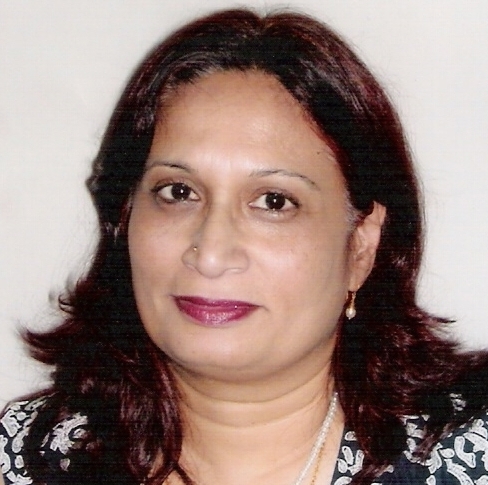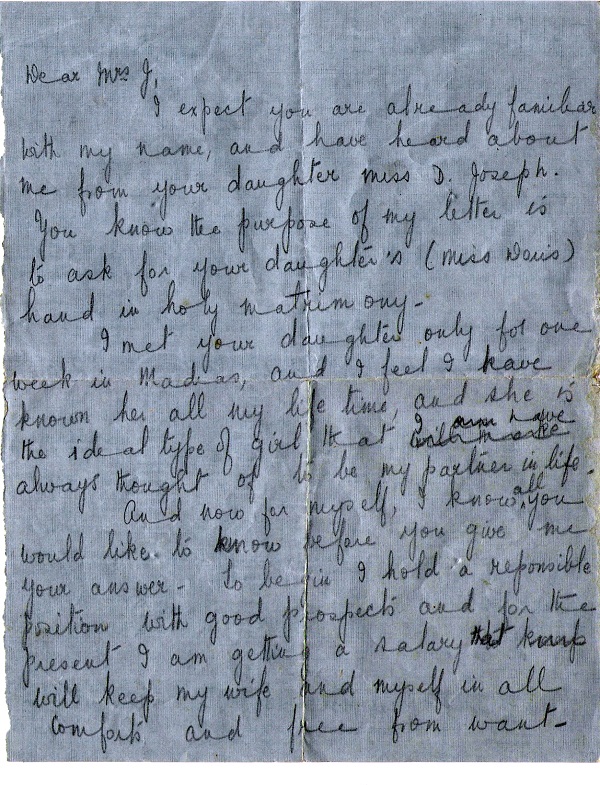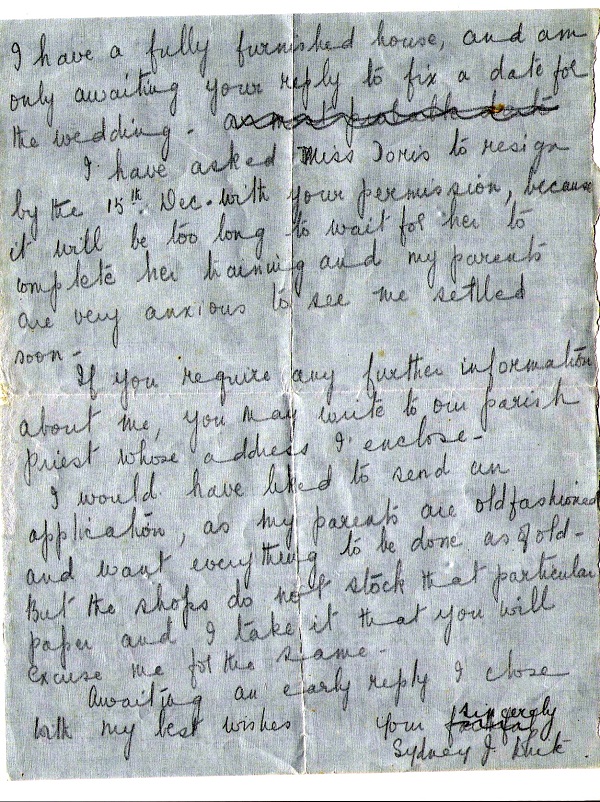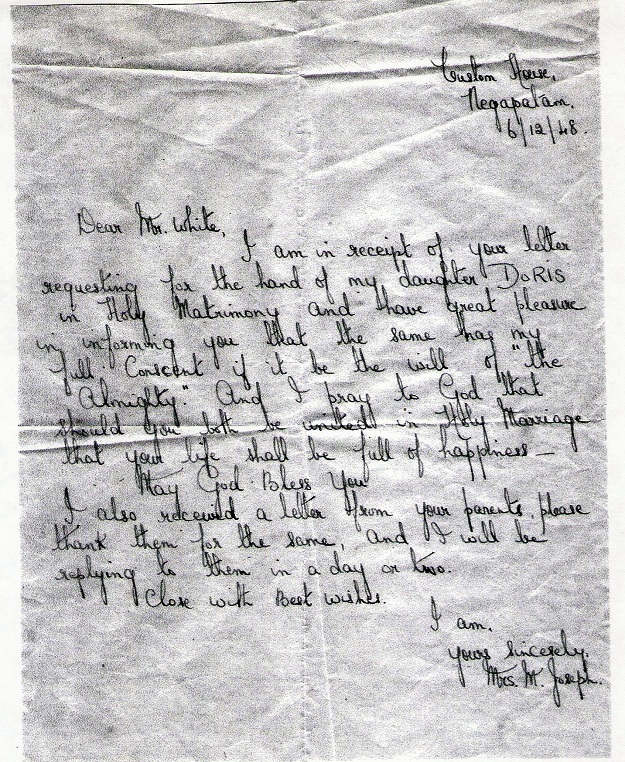Latest Contributions
Read More Contributions
Memories of my family and of weddings in Kolar Gold Fields
Category:

Bridget was born and brought up in Kolar Gold Fields, a small mining town in Karnataka. She got her B Ed degree in Bangalore, taught for two years, and then joined Canara Bank, from where she retired a few years ago. Now she is a self-published author of six cookbooks specializing in Anglo-Indian cuisine, and works as a consultant on food related matters. Bridget has also published a nostalgic book on KGF entitled Kolar Gold Fields Down Memory Lane. For copies of her books, contact her at bidkumar@gmail.com or visit http://anglo-indianfood.blogspot.com
My family
I was born and brought up in Kolar Gold Fields (KGF), a charming little mining town in the erstwhile Mysore State, which is now a part of Karnataka. I was the second born child to Sydney and Doris White. My brother John was born two years earlier than me, and my younger sisters Maryanne and Bernadette were born two and four years after me, respectively. We were a well-known Anglo-Indian family, which traced our roots to British ancestry on my paternal side and Portuguese and Dutch ancestry on my maternal side.
KGF had an old world charm and bonhomie about it and was known for its very affectionate and warm people. It was unique for its secular and egalitarian society not found anywhere else in the world. KGF was known as Little England due to its colonial ambience and European and Anglo-Indian population. The Kolar Gold Fields were owned and operated by a British mining firm, John Taylor and Sons, for almost a century. Four generations of my family lived and worked in KGF. Since we were part of the Anglo-Indian community, our lives were greatly influenced by the culture and ways of the British.
My dad, Sydney White, served as a Warrant Officer, (Staff Sergeant) in the Royal Mechanical and Electrical Engineers (REME) of the British Army during the II World War. He served in the Middle East, Eritrea, Malta, Egypt, etc. He was awarded the Africa Star for bravery and other medals and citations during his military tenure. After his release from the REME, he joined the KGF Mines as a Covenanted Officer. He worked as an Underground Engineer in Nandydroog Mines, and was in charge of the Section dealing with the Hoists, pipes and sand stowing functions underground. He had about 300 miners working under him. He was a strict disciplinarian as well as a kind Boss.
My mum also served in the British Army. She served as a Military Nurse in Wellington in the Nilgiris during the World War II. After the War she worked at the General Hospital (or G H, as it was known) in Madras. My parents met each other through my dad's cousin Millicent Fernando in Madras. They married after a short courtship on 26 January 1949 at Our Lady of Health Church in Velankanni.
As was the practice in those days, my dad had to write to my maternal grandmother formally requesting for my mum's hand in marriage. My maternal grandmother then replied in writing accepting him as a suitable husband for her daughter. I have much happiness and pleasure in sharing these two priceless letters with my readers. I am sure you will find them quite quaint and sweet.



Weddings in KGF
When I was growing up, weddings in my community in KGF were grand occasions, yet homely and full of fun. Since KGF was such a small place, everyone knew each other. Most of the Anglo-Indian families were invited for every wedding either from the bride's side or from the bridegroom's side.
In the early years, arranged marriages were the norm in the Community. Parents of girls would always be on the look out for "good boys" from "good families" for their daughters. Girls were not allowed to mingle freely with boys and were always chaperoned by their mother's and aunts at parties and get-togethers. However, towards the beginning of the 20th Century, a small change set in and boys and girls started falling in love. They mostly ‘eyed' each other at Church or at other functions and events. Eloping and marrying was very rare and they would inform their parents of their intentions when they decided to get married. The parents then took it from there - where the boy's family would approach the girl's family for her hand in marriage.
Preparations for an Anglo-Indian wedding would start months in advance. The bride and groom's families would meet to decide on the details of the wedding. These included the venue, the theme, the colours of the wedding, the Church Service, the hymns to be sung at the wedding, the number of bridesmaids and best men, the number of flower girls, the venue for the reception (almost all weddings receptions were held at the Skating Rink), the menu for the reception dinner, the wedding favours, the decorations, the Centre Piece, the Entrance Piece, etc. They were all serious issues that were discussed threadbare and decided after forming a joint consensus.
The total expenses for the wedding would be worked out and budgeted. The expenses shared equally by both families. Unlike other Indian communities, Anglo-Indians did not follow the tradition of dowry, and hence there are no demands from the bridegroom's side for money or gifts. It was left to the bride's family to give their daughter and new son-in-law whatever they could afford to give them.
The wine for the great day was either prepared by the bride's family or ordered from another Anglo-Indian family. The cake and its design were also discussed by both sides, and then an order for the same was duly placed with the Cake Maker or Bakery. Depending on the number of guests invited, slices of the wedding cake, wrapped separately in cellophane paper, were also ordered. All these preparations went on in full swing and were ready by the time the wedding day drew near.
The bride's wedding dress, a flowing snowy white gown, and the dresses of the flower girls, bridesmaids, the bride's mother and other family members, were normally tailored in KGF by the local tailors, who were expert dressmakers. These tailors could copy any pattern or design given to them but most often, they would design the wedding dresses themselves. Some of the more affluent families had their wedding dress and the bride's maids' and flower girls' dresses tailored in Bangalore or Madras.
Some lucky brides who had relatives abroad got their wedding dresses either from the UK or Australia.
The bridegroom's suit and the suits of the best men, pageboy, and other male family members were also tailored at KGF.
The actual wedding day was full of fun and activity right from the morning. The bride and the bridesmaids had their makeup and hair done at the bride's residence by one of the Anglo-Indian ladies who were experts in hair dressing We had no beauty parlours in those days, so it was a friend of the bride who normally did her make up for her.
The bride was not allowed to see the bridegroom on the day of the wedding as it was considered inauspicious or unlucky. Meanwhile, all the men and boys in both families would go to the Church and the Skating Rink to decorate it for the reception. The flowers for the Church were usually brought in from Bangalore. In no time at all, it would be time for everyone to leave for Church for the wedding.
The wedding service was always solemn and touching. The bride would look radiant and the bridegroom handsome. Many in the congregation would be seen wiping a tear, as weddings always make some people cry. Emotions are always high at weddings. All too soon, the wedding service would be over, and the couple were now man and wife.
After the church service, the bride and bridegroom normally went for a drive to have some precious moments alone together before the Reception. Their drive was invariably to the The Big Banyan Tree (a popular picnic spot) on the outskirts of KGF on the KGF-Bangarapet Road, where the Bharat Earth Movers Ltd., factory stands today. The calm and serene surroundings of the "Big Tree" gave the newly weds time to unwind and cuddle after the Church Service.
When they returned for the grand reception, all the guests would have gathered at the Skating Rink for the reception. The reception was always a homely, joyous affair, and everyone had a good time. Wine and spirits (Whiskey, Brandy, Rum and Beer) was invariably served and the bar would remain open till the end of the Reception. The Wedding March, the Waltzes, the Fox Trots, the Birdie Dance, the Cha Cha, Salsa, etc. had everyone joining in and tapping their feet to the music played by one of the local Anglo-Indian Bands.
Before the end of the Reception, all the young unmarried girls would gather in a circle. The bride, who was blindfolded, would throw her bouquet for them to catch. The lucky one to catch the bouquet was considered to be the next bride.
Likewise, all the young unmarried boys, gathered in the same way, and the bridegroom's Buttonhole Favour was similarly thrown to the group. The young man who caught the favour would then be paired with the young girl who caught the bride's bouquet, and they went round the Hall to the tune of the wedding march.
Our community in those days followed the adage that ‘Marriage was for keeps'. It was considered a sacrilege to remove the wedding ring under any circumstances. Divorce or separation was unheard of. The very word Divorce was not even uttered. Most of the older Anglo-Indian Folk married when they were very young, and their parents instilled in them that marriages were forever. Hence, they stuck together in spite of all problems. They took their marriage vows seriously and lived together in good times and bad, in sickness and health, till the demise of either one of them. They in turn passed this on to their children and grandchildren, and were quite scandalized when the present generation took their wedding vows lightly.
_______________________________________
© Bridget White-Kumar 2012
Comments
interest in your familiy photographs
Add new comment